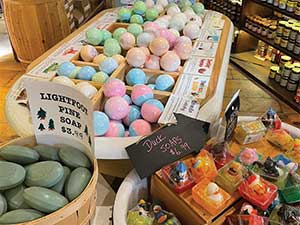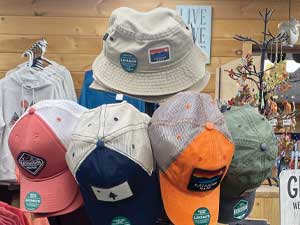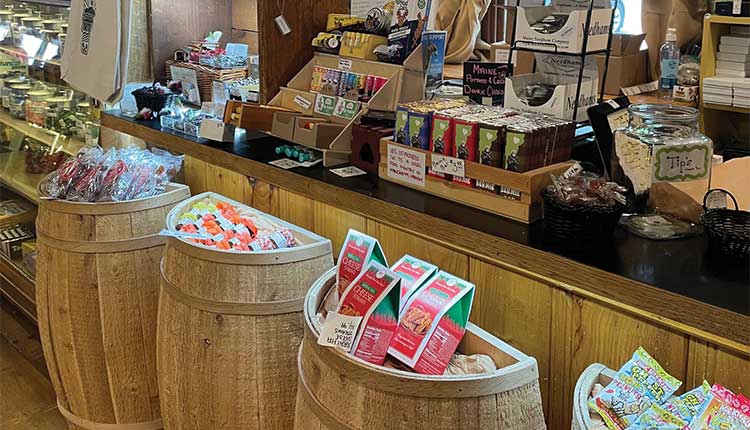Alluring prices and displays make it hard to say no to impulse buys.
What inspires shoppers to open their wallets and shell out for a souvenir? Eye-catching displays and irresistible price points are key, according to retailers. Local merchandise that caters to tourists doesn’t hurt, either.
“When people are on vacation, they just buy whatever they want. They don’t always look at the price,” says Suzanne Strattner, manager at the Hogback Mountain Country Store in Marlboro, Vermont. “That contributes to impulse buying.”
On a remote stretch of Southern Vermont’s scenic east-west road, tourists are usually grateful to find a bathroom and a bite to eat at Hogback Mountain County Store. That gratitude makes it easy to sell souvenirs, Strattner says: “They’ll say, ‘Well, we’ve got to buy something here, since we used the bathroom,’” Strattner says with a smile.
More often than not, that purchase is a miniature charm. The store’s top-selling impulse items are tiny Christmas gnomes, bluebirds of happiness, coffee cups and other figurine charms whose diminutive size — from a half-inch to an inch and a half — is inversely proportional to their popularity.
“We’ve even got unicorns that the little girls love, with little rhinestones in them,” Strattner says. Packaged alongside explanatory cards and little mesh bags, the $5 charms are irresistible as keepsakes or novelty gifts; Strattner herself keeps a few on the kitchen window.
Price point is crucial to spontaneous purchases, with many retailers putting the sweet spot at $10 and under. At Hogback Mountain Country Store, other favorites include a line of $3 to $4 lip balms from a Maine artisan in flavors like coconut and vanilla. Inexpensive and practical, they’re an easy sell to tourists who appreciate locally sourced products. “We support and promote small, family-run businesses in New England,” Strattner says. “That’s our buying strategy, and that’s what our shoppers like.”
Hungry, road-weary travelers are also likely to snap up edible treats like cider donuts, fudge and maple sugar. The store is known for its selection of caramels and other old fashioned candies that inspire nostalgic impulse buys. More recently, Hogback Mountain does a brisk business in “Bernie bars” — $4 chocolate bars in milk, almond and dark varieties bearing the crotchety, mittened likeness of Vermont’s own Sen. Bernie Sanders. With a $4 price tag, a local provenance and 10% of each purchase donated to a local food bank, “those sell like crazy,” Strattner says.
Local charm is irresistibleTo find winners like the Bernie bars, Strattner makes a beeline each year for the New England Made trade show where she’s sourced everything from coffee to candles. With tourists of all ages and backgrounds, “you’ve got to have price points for everybody,” says Strattner. “We have sweatshirts that are $70, but we also have sweatshirts that are $27.”
Most patrons are inspired to open their wallets by a country store overflowing with old timey charm. Strattner sets a New England vacation mood with wooden antiques and other vintage props; from the store’s mountaintop veranda, customers are treated to a million dollar view. “I try to post new things daily on Facebook, too,” Strattner says.
Whether in the mountains or by the sea, vacationers spring for items with a local angle.
At Katahdin General Store in Millinocket, Maine, the best-selling stickers, mugs and ball caps bear Maine or park logos. “Going to trade shows is key for getting new, unique designs,” says owner Michelle Brundrett. “I also advise having certain vendors you can rely on for good quality products.”
 Price points of $10 and under are the sweet spot for impulse buys such as nostalgic candy at Hogback Mountain Country Store.
Many retailers say that displaying impulse trinkets by the register, where people already have their wallets out, is a winning strategy. At Katahdin General Store, a checkout display tempts tourists with local souvenirs like stickers branded with the logo of nearby Baxter State Park.
“They’re multi-purpose and inexpensive, and people put them everywhere — on water bottles, laptops, cell phones, even cars,” says Brundrett. But what really boosts sticker sales is a recent promotion: $5 apiece, or three stickers for $7. “Since we changed our pricing strategy, our sales have increased tremendously,” Brundrett says.
“My mom always gave a free shell to every child who came in, and my daughter carries on the tradition. And for 45 years, they’ve been coming back.” — Christine Sheil, Shell Boutique
For many stores, these small-ticket purchases don’t make a huge contribution to the bottom line. But spontaneous add-ons do boost the per-order item count — and while inexpensive, many trinkets boast huge profit margins. Katahdin’s stickers, for instance, yield profits of more than 100%.
Stickers might be the number-one impulse buy, but name-drop ball hats are a close second. “Hats are one of the things people don’t intend on buying when they come in, but they usually end up walking out with one,” Brundrett says. Coffee mugs round out the bestsellers, which are strategically displayed along an aisle leading to the cash register. On the way out, patrons will also grab souvenir magnets or keychains, or fishing poles and water shoes for spontaneous park adventures.
Quantity makes a differenceOn Rhode Island’s Narragansett Bay, veteran retailer Christine Sheil is part of a three-generation empire built one seashell purchase at a time. Sheil’s mother, Marie Collins, founded Shell Boutique nearly 50 years ago — and quickly discovered that with enticing racks of sand dollars and scallop shells, she could equal the revenue of local T-shirt retailers whose average price tag was 10 times higher.
“My mom’s whole thing was, never gouge the customer, because we want them to come back,” says Sheil, whose daughter, Lisa Roy, is now the shop’s owner. “My mom always gave a free shell to every child who came in, and my daughter carries on the tradition. And for 45 years, they’ve been coming back.”
 Hats are displayed along an aisle leading to the cash register at Katahdin General Store. Repeat vacationers pop in every summer to see what’s new at Shell Boutique. Inexpensive seashell earrings, pendants and other souvenir trinkets typically retail for $12 and under, which Sheil says is key to impulse buys. “Our handmade sea glass and shell jewelry is very popular — everyone wants to wear it when they’re here,” says Sheil.
Collins, who died in 2011, used to source shells from Florida’s Sanibel Island, handcrafting ornaments and the owl trinkets that became her signature. Her granddaughter, Roy, learned the souvenir trade alongside her, first getting behind the register at five years old. Nowadays, Roy scours trade shows for inexpensive, beach-themed items to lure customers around that same register.
Rope bracelets, starfish and glass mermaid figurines are all popular add-ons. Wind chimes, novelty signs and other nautical crafts from local artisans are also hits with Narragansett’s summer beach crowd.
Over nearly five decades, the retail family has learned what kinds of merchandise tempts shoppers — and how best to display it. “You don’t want to put an item way on top of the wall so people can’t touch it or feel it,” says Sheil. “We make sure everything is accessible for customers to try on.”
With a steady base of regular patrons, Roy also changes up displays frequently. If something’s not selling, she’ll move it up front, “and all of a sudden people see it,” says Sheil.
And that, after all, is the essence of a successful impulse sale. Dangling tempting, low-cost trinkets in front of receptive tourists is a strategy that has sustained Shell Boutique and countless other souvenir retailers. “My mom was known as the shell lady. Now my daughter is the new shell lady,” says Sheil. “Go to the shows, buy what you love and know what your customers want — that’s key.”
|



